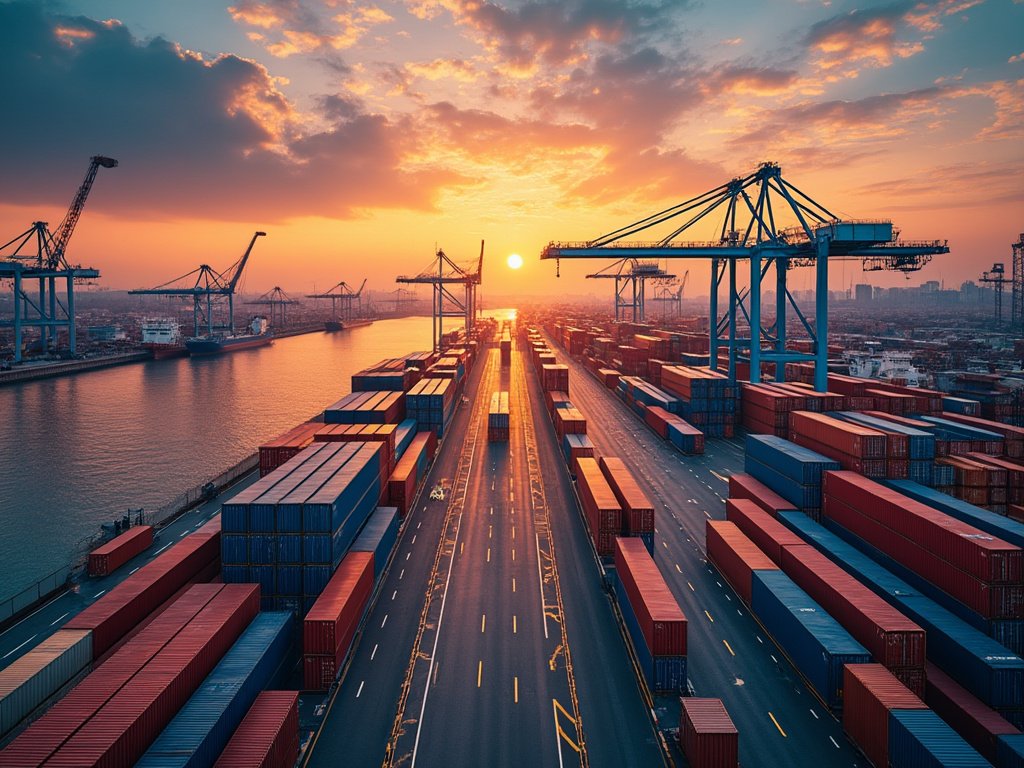
Global Trade Tensions Escalate Under Trump Administration
The rise of protectionist policies mirrors the economic landscape of the 1930s as countries respond to U.S. tariffs.
In recent years, global trade dynamics have shifted dramatically, predominantly influenced by the policies of the Trump administration.
The imposition of widespread tariffs has ignited retaliatory measures from several nations, including China, Canada, and the European Union, leading to an unprecedented rise in trade barriers reminiscent of the isolationist trade policies of the 1930s.
Prior to the Trump administration, nations were already elevating their trade barriers, particularly against China, to safeguard domestic industries such as electric vehicles and steel.
The situation has intensified following increases in U.S. tariffs, with the European Union announcing efforts to shield its industries from U.S. trade shifts.
Economists express concerns over the long-term repercussions on economic growth and international cooperation.
While the world is not currently experiencing a recession comparable to that of the 1930s, the effectiveness of the World Trade Organization (WTO) has waned.
President Trump has threatened to expand the trade conflict to additional commodities, including pharmaceuticals and automobiles.
Responses from other countries have been swift; nations such as South Korea, Vietnam, Mexico, Indonesia, and even Russia have enacted restrictions on Chinese goods.
Data from Global Trade Alert indicates that the number of trade restrictions among G20 countries has escalated by 75% since Trump took office, with over 90% of U.S. products subjected to import limits.
Estimates from Fitch Ratings indicate that if Trump's tariff threats materialize, the average U.S. tariff could rise to 18%, marking the highest levels seen in nearly 90 years.
Historical context reveals that tariffs in the 1930s, particularly through the Smoot-Hawley Act, prompted retaliatory trade actions that ultimately contributed to a decline in global trade.
The Smoot-Hawley Act raised U.S. tariffs on imports to roughly 20%, prompting major economies to respond in kind and exacerbating the economic downturn.
Following World War II, a significant shift occurred with the establishment of the General Agreement on Tariffs and Trade (GATT) in 1947, signed by the U.S. and approximately 20 other countries to reduce trade barriers and facilitate global economic recovery.
Tariff rates among major economies fell from approximately 22% in 1947 to about 3% in 1999, largely due to efforts to promote free trade.
In 1995, the WTO succeeded GATT, overseeing the global trade framework.
The liberalization of trade, while benefiting consumers through lower prices, has also been criticized for contributing to the decline of domestic industries in developed nations.
Many jobs have transitioned to countries with lower production costs, such as China, prompting the reimposition of tariffs during Trump's first term—a trend that has continued under President Biden.
In reactions to escalating tensions with China, the U.S. has implemented tariffs of 25% on Mexico and Canada, and 20% on Chinese imports, which Beijing has countered with retaliatory tariffs on U.S. soybeans and other products.
The EU has announced its intention to impose a 50% tariff on U.S. imports, including whiskey and motorcycles, starting in April.
The Trump administration has framed global trade as detrimental to the U.S. economy, working to reduce trade deficits with China, Mexico, Vietnam, and the EU while striving to revitalize domestic manufacturing sectors such as semiconductors and shipbuilding.
Proponents of Trump's policies argue they may lead to job creation and increased investment; however, the adverse effects of the trade war have been felt, particularly as consumers and businesses experience heightened uncertainty.
In Europe, BMW projected a billion-euro loss due to U.S. and European tariffs, warning of a potential negative spiral for the economy.
Fitch Ratings has cautioned that global economic growth may slow to 2.4% this year as trade disputes escalate.
Amidst these tensions, there’s a growing push for more tariffs aimed at protecting strategic industries from Chinese competition, such as electric vehicles and semiconductors.
The geopolitical landscape has shifted as the war in Ukraine prompts increased military spending and a push for economic self-sufficiency in Europe.
Experts highlight that the vision of economic integration between Europe and the U.S. has weakened, with governments now emphasizing national independence over collaborative economic policies.
The ability to revert to previous levels of trade openness faces challenges due to the waning influence of the WTO, particularly as the U.S. has obstructed the appointment of judges in the WTO's appellate body since 2019.
Despite ongoing disputes, efforts continue within the WTO to resolve conflicts, with leadership affirming the organization’s commitment to managing crises and mitigating tensions.
Economists note that reversing the imposition of tariffs is complex; under current geopolitical competition, particularly with China, the likelihood of reducing protectionist measures appears limited.
The imposition of widespread tariffs has ignited retaliatory measures from several nations, including China, Canada, and the European Union, leading to an unprecedented rise in trade barriers reminiscent of the isolationist trade policies of the 1930s.
Prior to the Trump administration, nations were already elevating their trade barriers, particularly against China, to safeguard domestic industries such as electric vehicles and steel.
The situation has intensified following increases in U.S. tariffs, with the European Union announcing efforts to shield its industries from U.S. trade shifts.
Economists express concerns over the long-term repercussions on economic growth and international cooperation.
While the world is not currently experiencing a recession comparable to that of the 1930s, the effectiveness of the World Trade Organization (WTO) has waned.
President Trump has threatened to expand the trade conflict to additional commodities, including pharmaceuticals and automobiles.
Responses from other countries have been swift; nations such as South Korea, Vietnam, Mexico, Indonesia, and even Russia have enacted restrictions on Chinese goods.
Data from Global Trade Alert indicates that the number of trade restrictions among G20 countries has escalated by 75% since Trump took office, with over 90% of U.S. products subjected to import limits.
Estimates from Fitch Ratings indicate that if Trump's tariff threats materialize, the average U.S. tariff could rise to 18%, marking the highest levels seen in nearly 90 years.
Historical context reveals that tariffs in the 1930s, particularly through the Smoot-Hawley Act, prompted retaliatory trade actions that ultimately contributed to a decline in global trade.
The Smoot-Hawley Act raised U.S. tariffs on imports to roughly 20%, prompting major economies to respond in kind and exacerbating the economic downturn.
Following World War II, a significant shift occurred with the establishment of the General Agreement on Tariffs and Trade (GATT) in 1947, signed by the U.S. and approximately 20 other countries to reduce trade barriers and facilitate global economic recovery.
Tariff rates among major economies fell from approximately 22% in 1947 to about 3% in 1999, largely due to efforts to promote free trade.
In 1995, the WTO succeeded GATT, overseeing the global trade framework.
The liberalization of trade, while benefiting consumers through lower prices, has also been criticized for contributing to the decline of domestic industries in developed nations.
Many jobs have transitioned to countries with lower production costs, such as China, prompting the reimposition of tariffs during Trump's first term—a trend that has continued under President Biden.
In reactions to escalating tensions with China, the U.S. has implemented tariffs of 25% on Mexico and Canada, and 20% on Chinese imports, which Beijing has countered with retaliatory tariffs on U.S. soybeans and other products.
The EU has announced its intention to impose a 50% tariff on U.S. imports, including whiskey and motorcycles, starting in April.
The Trump administration has framed global trade as detrimental to the U.S. economy, working to reduce trade deficits with China, Mexico, Vietnam, and the EU while striving to revitalize domestic manufacturing sectors such as semiconductors and shipbuilding.
Proponents of Trump's policies argue they may lead to job creation and increased investment; however, the adverse effects of the trade war have been felt, particularly as consumers and businesses experience heightened uncertainty.
In Europe, BMW projected a billion-euro loss due to U.S. and European tariffs, warning of a potential negative spiral for the economy.
Fitch Ratings has cautioned that global economic growth may slow to 2.4% this year as trade disputes escalate.
Amidst these tensions, there’s a growing push for more tariffs aimed at protecting strategic industries from Chinese competition, such as electric vehicles and semiconductors.
The geopolitical landscape has shifted as the war in Ukraine prompts increased military spending and a push for economic self-sufficiency in Europe.
Experts highlight that the vision of economic integration between Europe and the U.S. has weakened, with governments now emphasizing national independence over collaborative economic policies.
The ability to revert to previous levels of trade openness faces challenges due to the waning influence of the WTO, particularly as the U.S. has obstructed the appointment of judges in the WTO's appellate body since 2019.
Despite ongoing disputes, efforts continue within the WTO to resolve conflicts, with leadership affirming the organization’s commitment to managing crises and mitigating tensions.
Economists note that reversing the imposition of tariffs is complex; under current geopolitical competition, particularly with China, the likelihood of reducing protectionist measures appears limited.











